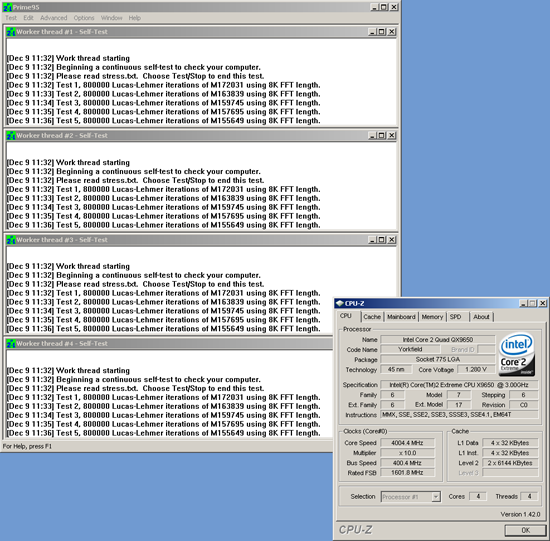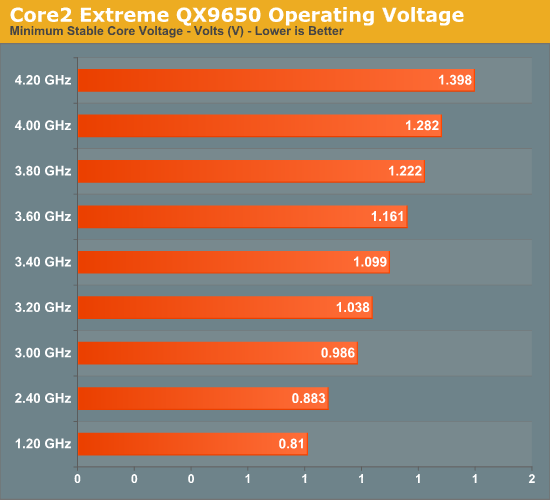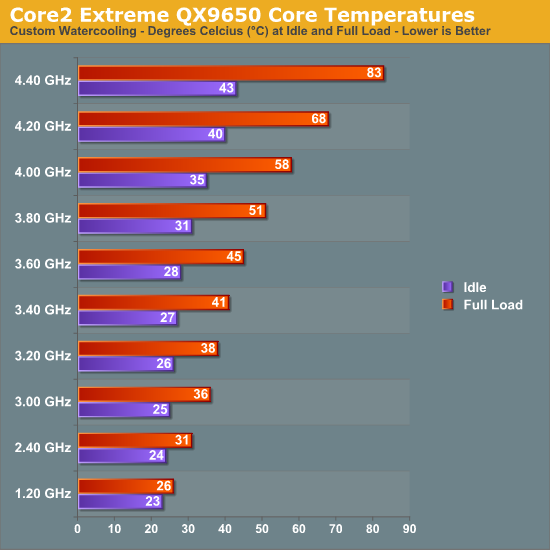Overclocking Intel's New 45nm QX9650: The Rules Have Changed
by Kris Boughton on December 19, 2007 2:00 AM EST- Posted in
- CPUs
Overclock That CPU
With the memory and memory subsystems out of the way, we are finally ready to see what the processor can do. Because we have already decided on our target FSB we must accept for the time being that our final CPU frequencies will be limited to discrete steeps equal to our FSB. This is by design and affords us the knowledge that any Prime95 errors met during our last testing phase come from the CPU and nothing else. As always, varying the processor's multiplier changes only the CPU frequency - if memory is stable at 8 x 400 then by definition it's also stable at 9 x 400. Assuming we have decided to run 1:1, in both cases, the memory continues to operate at DDR-800 regardless of CPU speed. Later you can tune your final clocks by adjusting the FSB if you so choose.
 All green means everything is good. Remember to give the program time to run |
Once again, enter your motherboard's BIOS, this time adjusting only the CPU multiplier and the CPU voltage to set a potential overclocking frequency. Using custom water-cooling we were able to scale our QX9650 as shown below. Please note that all processors are different and voltage response curves generated using one CPU are not directly applicable to another. Your processor may perform slightly better or worse and these illustrations are only a general guideline. (The values shown are full-load CPU supply voltages and not the VID settings that we had to set.)

After booting to the Windows desktop, fire up Prime95 once again, this time choosing the option to run small FFTs as this setting places maximum stress on your CPU and leads to the highest load temperatures. As before, run at least 30 minutes while watching for errors. There are a few different potential failure modes, the least severe being a rounding error which causes one or more of the calculation threads to quit, changing the child window icon from green to red. Normally, with 45nm processors this is a good indication of a memory error, but since we know the memory is stable we can safely blame the CPU. In this case, the corrective action is to increase the CPU VID by a single step and try again. If the system freezes or freezes and then quickly resets, you will need to increase the CPU voltage by more than a single-step increment. Save yourself the hassle of multiple failures, increase CPU voltage by 0.05V or more, and try again. Later, back this down if possible until the CPU is just above the minimum required Vcore.

Depending on the cooling in use, you may find your overclock temperature limited. The QX9650 has a maximum thermal specification of 64.5°C but can generally handle temperatures as high as about 70°C before heat becomes a significant factor in scaling. Besides the core temperatures, the voltage regulator module (VRM) supply current can also function as a limiting factor. We saw before just how much current, in amps, the VRM circuit must provide under CPU full-load conditions in order to maintain stability. Current in excess of about 160A can be quite straining for even high-performance motherboards - make sure you adequately cool this area with at least a single, low-speed 120mm or larger fan if you plan to push a board this hard.
One of the great new features of the 45nm Core 2 family of processors is the ability to make use of non-integer multipliers. Sometimes referred to as half-multipliers, these values allow you to step your CPU frequency in increments one-half that of your FSB. Overclockers intent on running 400MHz FSB can now use a 10.5x multiplier to set a final CPU frequency of 4.2GHz, up from 4.0GHz (when 4.4GHz may be unachievable) without even touching the FSB. Consider this potential advantage if your motherboard allows use of these settings.
After some time experimenting with what works and what does not, you should start to get a feel for how your system responds to changes. During this time you should also learn how your CPU scales with voltage and exactly what speeds and timings to use with your memory subsystem. This three-phase approach helps lay the groundwork for the development of key overclocking skills and provides those new to overclocking with some ideas on how to approach the subject. Only once you understand the theory behind this basic methodology can you begin to safely stray into uncharted territory.










56 Comments
View All Comments
Kougar - Thursday, December 20, 2007 - link
This was the exact type of article I love to sit down and read through. It doesn't matter if portions of it are above my head, it just gets me to rise up another level to grab at them. Your article was a great read and I very much hope to see many more like this one in the future!Regarding the P5E3, I am somewhat surprised that 0.81v was the lowest you could set. Even the budget board P31-DS3L offers 0.51v as an option, my personal P35-DQ6 has 0.50v as a vCore option. I found your commentary regarding Load Line Calibration to be illuminating... this is exactly what enthusiasts like myself and others need to know.
Lastly, I hate to ask here but Google was no help, Intel's ARK database didn't cover it, and Intel's datasheet didn't mention that I could see... what exactly is P35's process size and default vCore? The same as X38's...? As much as I love Gigabyte they are notorious for their lack of system voltage info...
kjboughton - Thursday, December 20, 2007 - link
The P35 and X38 chipsets are both made using Intel's standard 90nm process technology. It's not uncommon for chipset's to lag behind current CPU offerings by a whole process generation or more. With that being said, Intel's upcoming P45 chipset, the last of it's kind (recall that all future CPU technologies will make use of an onboard memory controllers) will be made on the 65nm process -- something even the X48 won't have. In fact, this reduction in process size may have considerable benefits for P45 when it comes to the reduction in power consumption and increased performance headroom, particularlly when overclocking. The P45 default Vmch is 1.15V, X38 is slightly higer at 1.25V. Based on this I would expect to see the P45 come in around 1.05V or possibly even lower.myocardia - Thursday, December 20, 2007 - link
Kris, great article. But, when did $400-500 worth of watercooling equipment become so commonplace, as to be putting the one (or is that two?) companies who make phase-change units out of business? If freon is no longer needed for extreme CPU cooling, couldn't Vapochill just start making even more expensive, higher-end watercooling?spamme33 - Thursday, December 20, 2007 - link
I have been overclocking since my first computer build years and years ago, rarely do I learn that much from one article. Very well written, informative, and timely!kilkennycat - Thursday, December 20, 2007 - link
The documentation accompanying the BIOS settings of almost all enthusiast motherboards is frequently obscure and incomplete - probably because it is printed many months before the board/BIOS is released, plus the leading manufacturers never bother to update BIOS user-documentation when they update the BIOS. Also, it does seem that the documentation authors have a uniformly poor grasp of the English language and prefer to keep descriptions of all BIOS settings as vague and incomprehensible as possible. It is also so common to find sundry BIOS entries not documented AT ALL anywhere in the motherboard manual, even the (so-called) latest on-line version.So I have a request on behalf of those like myself desperately trying to understand each entry in the BIOS of that brand-new and very expensive enthusiastic motherboard that I have just purchased, with that abysmal so-called user-manual and pathetic in-BIOS "Help" Function-key :-
Would it be possible for you or other at Anandtech to fully document/explain all the terms used in the text of the CPU and memory BIOS settings of the most popular enthusiast motherboards?
To keep such an exercise manageable, I suggest confining the exercise initially to existing and upcoming enthusiast desktop motherboards that are fully compatible with Penryn and Phenom. At present, X48, nVidia 780i, AMD 790FX.....
poohbear - Thursday, December 20, 2007 - link
thank you very much for such an informative and detailed article. very much appreciated for us overclockers and the future looks fantabulous w/ these cpus.wyemarn - Thursday, December 20, 2007 - link
Thank you very much for this great article. What a wonderful Christmas gift from Anandtech! This is one the most complete article I have ever read. CPU performance, overclocking, mobo settings, power consumption all in one article. What a joy to read.akaevile - Thursday, December 20, 2007 - link
Thank you for the detailed information. One has to be a little nervous however for the implications in what your work has found. Will Intel's improvements in refining 45nm technology push the line or has it been drawn in the sand??n7 - Wednesday, December 19, 2007 - link
Really superb article.Possibly the best i've ever seen on AT!
Thanx for the indepth info!
Bozo Galora - Wednesday, December 19, 2007 - link
looks like not only the X48, but three 45nm quads also will be delayed - due to AMD incompetence.http://www.digitimes.com/mobos/a20071218PD212.html">http://www.digitimes.com/mobos/a20071218PD212.html